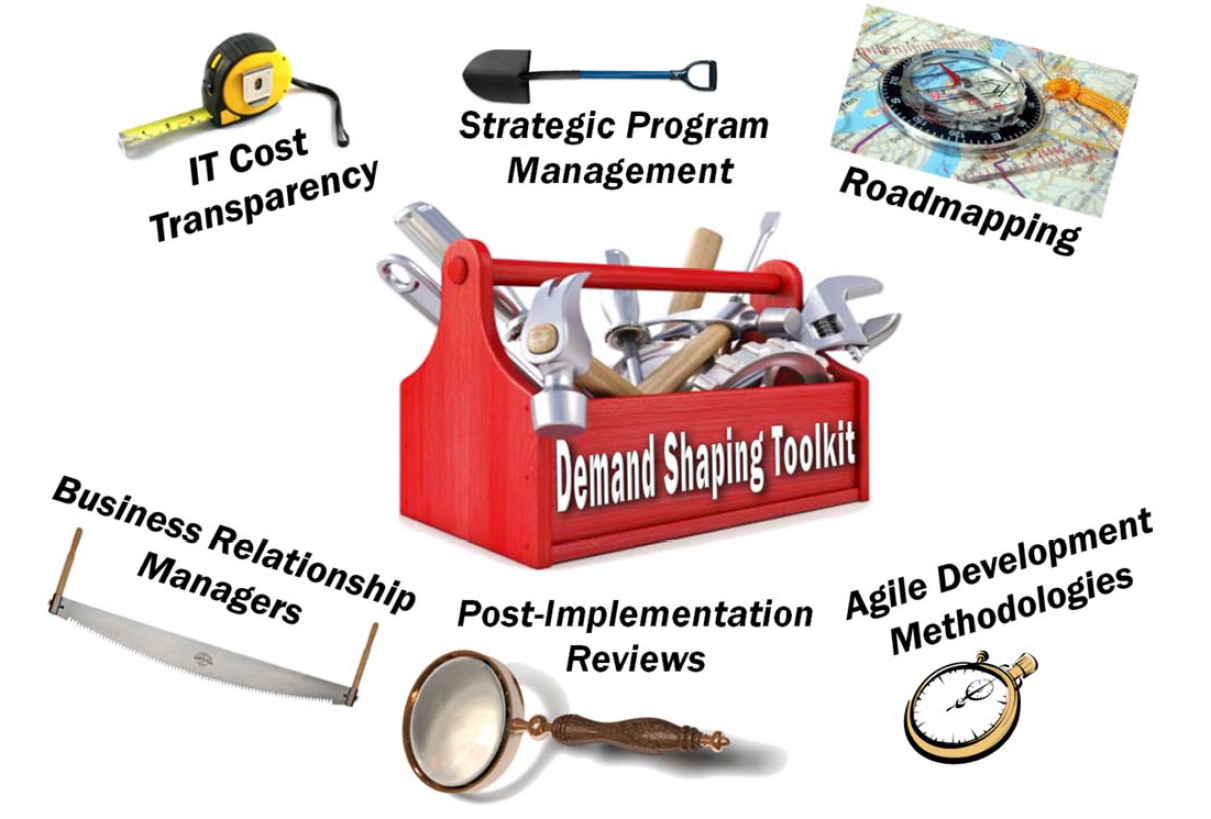A CIO recently told us that demand for IT-related projects in his financial services company was “overwhelming.” He was not concerned about the IT unit’s ability to deliver a growing project portfolio. Rather, he was concerned about the capability of his company to absorb all the changes that the requested projects would require. He doubted that the company could generate the expected benefits.

Demand Shaping: The IT Unit's New Passion
Abstract
In the Digital Economy, companies must be strategic in choosing their IT projects. This briefing identifies six “demand shaping” tools that leading-edge companies are using to ensure that their IT project portfolios pursue their most valuable and achievable opportunities. While the tools themselves are not new, what is new is that firms are using them specifically to build IT savvy and to concentrate investments on strategic IT capabilities. The tools include making IT costs transparent, strategic program management, roadmapping, agile development methodologies, post-implementation reviews, and business relationship managers.
MIT CISR research suggests that success in shaping IT demand will distinguish winners from losers in the digital economy.
Welcome to the Digital Economy, where the appetite for IT services is immediate and insatiable. Thanks to new and improved sources of IT supply (e.g., mature outsourcing arrangements like staff augmentation, the growing availability of cloud services, and the increased enterprise acceptance of reusable IT and business process components), IT units are less often the constraint in introducing new business capabilities. Instead, the need to constantly change the business while simultaneously doing business requires companies to be strategic in choosing their IT-enabled business change projects.
How do companies decide which potential projects will be most valuable—and then limit their portfolios to projects that will actually realize value? Six MIT CISR case studies and interviews with twenty-six IT leaders suggest that many IT units are taking on responsibility for ensuring that the company’s project portfolio creates strategic value. We refer to the efforts of these IT units as demand shaping.
Our research suggests that success in shaping IT demand will distinguish winners from losers in the digital economy. In this briefing, we define demand shaping and describe six tools that are enhancing demand shaping in the companies we have studied.
What Is IT Demand Shaping?
IT demand shaping bears little resemblance to demand management, the annual task of deciding which projects will be funded and which will not. In some companies, project funding decisions fall to IT leaders who typically fulfill as much demand as possible. More often, an IT steering committee takes responsibility for ensuring that the project portfolio addresses enterprise priorities. But regardless of the sincerity of their intentions, members of a steering committee cannot possibly understand the implications of all the proposed projects. They rely on business cases to elaborate on the value of a proposed project, a process that encourages gamesmanship or horse trading. The outcome is often a project portfolio that satisfies no one and does not build strategic, long-term capabilities.
We define demand shaping as a process of ongoing negotiation and learning about a company’s most valuable and achievable business change opportunities through which leaders develop a prioritized list of IT-enabled business capabilities. The goal of demand shaping is enhanced strategic impact from IT through informed allocation of business and IT resources.
Demand shaping invariably involves cultural changes. Instead of proposing a list of good ideas for their area of responsibility, business leaders jointly pursue critical business capabilities that can distinguish the company from its competitors. Demand shaping involves sequencing the development of enterprise business capabilities and then identifying ways to leverage them throughout the company.
Companies should see the impact of demand shaping on (1) increased business leader satisfaction with the project portfolio; (2) greater reuse of technology and business components; (3) greater financial return on technology-enabled business change projects; and (4) improved speed to market. Many companies do not currently measure these outcomes and may need first to establish a baseline.
These metrics don’t just help companies to assess the impact of demand shaping; they also focus attention on the factors that are defining success in the digital economy.
How Do Companies Shape IT Demand?
While many IT leaders have started to develop competence in demand shaping, none of the companies we have studied are yet satisfied with the impact IT is having on their company. We have identified a set of tools that these IT leaders are deploying to help shift their companies from a mindset of demand management to a process of demand shaping. Figure 1 shows these tools:
IT cost transparency: By exposing the costs of operational and project-related IT services, IT leaders help business unit leaders understand the ongoing financial impacts of their IT investment decisions. This effort requires explicit links between IT costs and their cost drivers. Cost transparency depends on assigning costs to both infrastructure and application services, which is a labor-intensive effort.
BMW approached IT cost transparency by authorizing its infrastructure management team to convert three hundred unmanaged line items into user-centric services.[foot]A. Quaadgras and P. Weill, “Globalizing IT Operations at BMW: Transparency and People,” MIT Sloan CISR Research Briefing, Vol. IX, No. 11, November 2009, https://cisr.mit.edu/publication/2009_1101_BMW_QuaadgrasWeill[/foot] Over a period of eighteen months, BMW established a set of forty-one clearly defined, measured, and delivered services, which helped business leaders both understand and manage their IT costs.
Nothing accelerates organizational learning about the value of IT as much as post-implementation reviews.
Strategic program management: Strategic program management involves identifying a finite set of strategic goals and then assigning a program leader to manage all projects related to achieving a goal. This arrangement helps to expose projects that are not strategic (because they don’t fit into any of the programs) and assigns responsibility for defining the critical capabilities required for each strategic goal. Program managers should be empowered to shift funds among projects to reflect constantly changing business conditions and project realities.
As a precursor to strategic program management, it is useful to develop service managers who take on responsibility for the quality, cost, and delivery of shared business and IT services. Service managers make decisions as to when existing systems should be enhanced, retired, or simply sustained. Procter & Gamble has long relied on service owner roles to develop enterprise capabilities.[foot]P. Weill, C. Soh, and S.K. Sia, “Governance of Global Shared Solutions at Procter and Gamble,” MIT Sloan CISR Research Briefing, Vol. VII, No. 3A, December 2007, https://cisr.mit.edu/publication/2007_12_3A-GovatPG-WeillSohSia[/foot]
Roadmapping: Roadmaps help leaders across the enterprise identify how they can incrementally address the biggest gaps in their business capabilities. IT leaders identify key infrastructure services (for example, a shared data environment or common security reference) that are essential to the company’s ability to enact a business vision. The roadmap provides a sequence for the implementation of the infrastructure services and related business capabilities so that services start generating value as soon as they are implemented.
Roadmapping often starts with application portfolio management, during which IT and other business leaders learn what applications exist. They identify redundancies in their systems— multiple systems fulfilling common needs in only slightly different ways—and then map out which systems should be retired or revamped. This simplifies the systems environment and facilitates delivery of shared platforms.
Agile development methodologies: The hardest part of getting from a roadmap to valuable systems is the conversion of abstract ideas into specific, implementable requirements. Agile methodologies engage business users in intensive design work in fast feedback cycles. System users and sponsors learn early on the meaning of the roadmap and the functionality and impacts of proposed changes.
To move toward agile methodologies, all companies can adopt a key practice of software companies: establish release dates and define functional requirements in terms of what can be ready by a release date. Southwest Airlines found that adherence to release dates increased discipline in requirements management and accelerated the pace of learning about the value of new capabilities[foot]Source: Interviews with Southwest Executives, August–September 2011.[/foot]
Post-implementation reviews: Post-implementation reviews (which should actually be conducted during, as well as after, project implementation) help expose what does and does not lead to business value. Repeated MIT CISR studies suggest that nothing accelerates organizational learning about the value of IT as much as post-implementation reviews.
Companies have struggled to adopt post-implementation reviews. One way to get started is to monitor new system usage. Many systems are grossly underutilized—and no one knows it! Two CIOs reported immediate business sponsor action when usage statistics revealed that new systems could not be having their intended business impact.
Business relationship managers (BRMs): Business relationship managers (a.k.a. IT account managers, business unit CIOs, or advisor leads) are likely to be the secret sauce that makes demand shaping work—or not. An effective BRM engages throughout the year in conversations with functional and business unit leaders about what is and isn’t working in their efforts to optimize business outcomes. These conversations help BRMs articulate needed capabilities and design roadmaps.
One way to increase the impact of BRM roles is to limit the number of individuals who can propose IT projects for funding. If only people who can be held accountable for realizing value from the company’s project portfolio are allowed to make proposals, a finite number of BRMs can work with them to establish priorities and develop a roadmap. TetraPak took this approach when it authorized only its global business process owners to propose projects.[foot]Source: Discussion with Per-Åke Tobiasson, October 2010[/foot]

Figure 1: Tools Companies Use to Shape IT Demand
© 2014 MIT Sloan CISR, Ross and Beath. CISR Research Briefings are published monthly to update MIT CISR patrons and sponsors on current research projects.
About the Authors
MIT CENTER FOR INFORMATION SYSTEMS RESEARCH (CISR)
Founded in 1974 and grounded in MIT's tradition of combining academic knowledge and practical purpose, MIT CISR helps executives meet the challenge of leading increasingly digital and data-driven organizations. We work directly with digital leaders, executives, and boards to develop our insights. Our research is funded by member organizations that support our work and participate in our consortium.
MIT CISR Associate Members
MIT CISR wishes to thank all of our associate members for their support and contributions.

